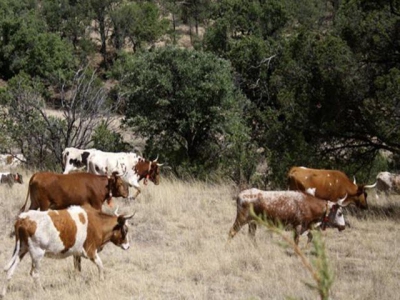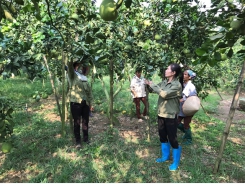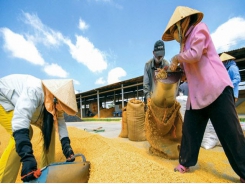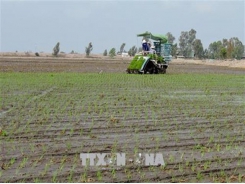Arid lands ranching focus of high-tech project

New Mexico and Texas researchers seek economical and sustainable arid lands beef management practices.
Precision ranching is a focus of a new coordinated agricultural project led by New Mexico State University (NMSU) in collaboration with Texas A&M AgriLife Research in Amarillo, Texas.
Working under an almost $9 million grant from the U.S. Department of Agriculture's National Institute of Food & Agriculture are agricultural engineer Brent Auvermann, director of the Texas A&M AgriLife Research & Extension Center in Amarillo, Texas, and Jenny Jennings, beef nutritionist in Amarillo.
The project’s goal is to improve efficiency of beef production by identifying socioeconomic and environmental trade-offs associated with heritage cattle genetics, precision ranching and various supply chain options, including range finishing, the announcement from Texas AgriLife Research said.
“We’re aiming to diversify options for arid lands ranchers and the U.S. beef industry as they work to maintain and improve the sustainability of beef production in the southwestern U.S.,” said Sheri Spiegal with the USDA-Agricultural Research Service's Jornada Experimental Range.
According to the announcement, the five-year project will compare heritage versus conventional desert-adapted cattle in studies on profitability, input efficiency, ecosystem effects, feedyard performance and carcass and meat quality.
As part of the project, a long-term replicated grazing experiment will be established at the NMSU Chihuahuan Desert Rangeland Research Center to assess differences in the productivity, behavior and ecological effects of a Raramuri Criollo herd compared to a more traditional Brangus system, AgriLife Research noted.
Raramuri Criollo are a biotype of Criollo cattle that originally were brought to the Americas by Spanish conquistadors and currently are raised by the Tarahumara people of Copper Canyon in Chihuahua, Mexico.
“The herd will be pure Raramuri Criollo that will be crossed with Brangus,” said Andres Cibils with the NMSU department of animal and range sciences. “The calves will be crossbreds, but we want to start with a cow herd of straight-breds, both of Raramuri Criollo and Brangus.
“We want to take advantage of the (Raramuri Criollo) traits that cause them to be more desert-friendly grazers while crossing them with beef breeds to obtain faster-growing offspring that can be sold as beef calves at weaning,” he said.
Cibils said the Raramuri Criollo herds of cattle in Chihuahua’s Copper Canyon have been fairly isolated, with little to no influence of British or Indicus beef cattle breeds, and they are being studied at the Jornada Experimental Range northeast of Las Cruces, N.M.
“This project is reaching back into history for cattle genetics and forward into the future for advanced technologies,” Auvermann said. “The Criollo genetics bring arid lands hardiness to the table, while advanced sensors and communications systems make it possible to manage extensive landscapes in near-real time.”
Concurrently, collaborating ranches will maintain red Angus and Raramuri Criollo-crossed red Angus herds or black Angus and Raramuri Criollo-crossed black Angus herds, all starting with purebred Raramuri Criollo cows, AgriLife Research said.
Weaned calves will be purchased from the three ranches and transported to irrigated wheat pasture at NMSU’s Clayton Livestock Research Center.
Each spring, heifers and steers will be sent to the Clayton center feedlot and the AgriLife Research feedlot at Bushland, Texas. Jennings will run the finishing trials at the Bushland feedlot.
“Because we’re looking for subtle differences in feed-to-gain performance and meat quality, we’ve got to have precise control of the finishing phase for these cattle,” Jennings said. “Our research feedlot at Bushland gives us that control.”
Each fall, processing and carcass trials will take place at the Tyson Fresh Meats plant in Amarillo.
Jennings noted that Bushland’s proximity to West Texas A&M University is a major plus because of the university’s Beef Carcass Research Center, directed by Ty Lawrence, who will coordinate the processing and carcass trials.
Beyond the carcass quality evaluations, consumer taste and tenderness evaluations will be conducted at Texas A&M University under the direction of Rhonda Miller, meat science professor in the department of animal science, the announcement said.
“Americans’ tastes in beef can be pretty sophisticated, so we’ve got to tie our work to consumer preferences,” Auvermann said. “If the consumer market rejects our product, we’ve got to adjust our production systems.”
Developing technology
AgriLife Research said an important part of the research project will be developing and field testing a wireless precision ranching system to provide real-time information on weather, water sources and animal position to better understand the environmental and socioeconomic linkages.
Sensor technologies will be tested on five participating ranches, so a market-ready product will be available for purchase and deployment on ranches when the project wraps up.
The proposed precision ranching system will be able to log, transmit and analyze sensor data in real time, the announcement said. It will include Ranch Dashboard, a computer graphical interface that will display sensor data, allowing a rancher to monitor weather conditions, water levels in livestock drinkers such as above-ground permanent watering troughs and animal positions in close to real time. Additionally, warnings will be generated when user-defined thresholds are crossed.
Researchers will use an Integrated Farm System Model (IFSM) developed by the Agricultural Research Service to compare the environmental footprints and enterprise economics of production scenarios that represent different combinations of the cattle genetics, precision technologies and supply chain options under investigation in order to weigh their trade-offs in long-term sustainability, AgriLife Research said.
Partnering ranchers and feedyard operators will provide information on their operations the first two years, including land use and annual requirements of water, labor, fuel, electricity and other important resources to inform the IFSM model. Purchased feeds will be monitored to quantify feed intake and the flow of nutrients into and from the production system.
Cattle growth rates, replacement rates, mortalities, animals purchased and sold and their weights will be used to quantify the flow of animals through the production system, according to the announcement. The information provided will be used to develop production scenarios for the Southwest U.S.-Ogallala Aquifer beef production area and, ultimately, to help to identify trade-offs of different supply chain options.
Related news
Tools

Phối trộn thức ăn chăn nuôi

Pha dung dịch thủy canh

Định mức cho tôm ăn

Phối trộn phân bón NPK

Xác định tỷ lệ tôm sống

Chuyển đổi đơn vị phân bón

Xác định công suất sục khí

Chuyển đổi đơn vị tôm

Tính diện tích nhà kính

Tính thể tích ao




 Firms cautioned when exporting pepper to Myanmar
Firms cautioned when exporting pepper to Myanmar  Agriculture sector expands by 2.02% in nine months
Agriculture sector expands by 2.02% in nine months